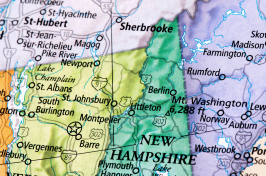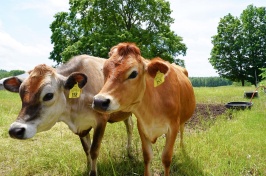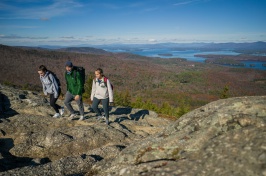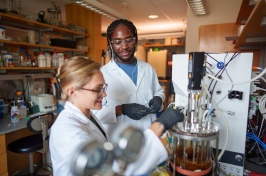The University of New Hampshire is a flagship research university that inspires innovation and transforms lives in our state, nation and world. More than 16,000 students from all 50 states and 71 countries engage with an award-winning faculty in top ranked programs in business, engineering, law, health and human services, liberal arts and the sciences across more than 200 programs of study. UNH’s research portfolio includes partnerships with NASA, NOAA, NSF and NIH, receiving more than $100 million in competitive external funding every year to further explore and define the frontiers of land, sea and space.
UNH Scientist Takes Aim at Invasive, Non-Native Plants Threatening NH’s Forests
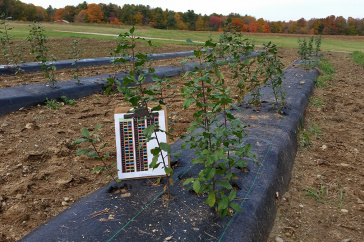
This new research project builds on previous research on non-native invasive species, such as glossy buckthorn. UNH researchers have planted an orchard of the fast-growing shrub at UNH’s Kingman Farm to determine the life history characteristics of invasive glossy buckthorn under controlled conditions, free from competition with other plants, and free from variation in other environmental factors such as soil or micro-climate. Credit: UNH
DURHAM, N.H. – A new research project at the University of New Hampshire will assess the status and distribution of invasive plant species throughout New Hampshire that pose the greatest threat to the state’s forest systems, with the goal to help foresters and landowners minimize the risk of invasive plants to the state’s economically important forests.
The project is led by John Gunn, research assistant professor of forest management, and a researcher with the NH Agricultural Experiment Station. Gunn also has an appointment at UNH Cooperative Extension.
“The health of New Hampshire’s forests faces many threats from non-native and invasive plants introduced over the last two centuries. These non-native species now make up at least 30 percent by species of all plants in New England. Several species already are widespread throughout the state, such as burning bush, glossy buckthorn, multiflora rose, and Japanese barberry. Warming temperatures in this century are likely to favor conditions for the expansion of existing populations of invasive plant species and facilitate newcomers to the state’s borders,” Gunn said.
This project aims to provide a statewide assessment of the status and distribution of invasive plant species throughout New Hampshire that pose the greatest threat to forest systems. The project also will evaluate factors that increase forest resistance to colonization by invasive plants. Based on these factors, Gunn plans to provide management best practice guidelines to help foresters and landowners minimize the risk of invasive plant species invasion into native forest stands.
“I’m interested in developing some tools where landowners and foresters can evaluate the risk to their forest lands and then adjust the way they manage their forests to reduce the risk of invasion. The tools will include an online ‘web map’ where landowners can use their location and other information about their forest land to evaluate their risk of invasion by several non-native species,” he said.
This material is based upon work supported by the NH Agricultural Experiment Station, through joint funding of the National Institute of Food and Agriculture, U.S. Department of Agriculture, under award number 1010675, and the state of New Hampshire. Gunn is collaborating with Jeff Bowman at Trent University and the Ontario Ministry of Natural Resources and Jarlath O’Neil-Dunne at the UVM Spatial Analysis Lab, who will be conducting Unmanned Aerial System flights and analyzing the multi-spectral data collected during the flights.
Founded in 1887, the NH Agricultural Experiment Station at the UNH College of Life Sciences and Agriculture is UNH’s original research center and an elemental component of New Hampshire's land-grant university heritage and mission.
PHOTOS AVAILABLE FOR DOWNLOAD
https://colsa.unh.edu/nhaes/sites/colsa.unh.edu.nhaes/files/media/images/unhbuckthornproject.jpg
This new research project builds on previous research on non-native invasive species, such as glossy buckthorn. UNH researchers have planted an orchard of the fast-growing shrub at UNH’s Kingman Farm to determine the life history characteristics of invasive glossy buckthorn under controlled conditions, free from competition with other plants, and free from variation in other environmental factors such as soil or micro-climate. Credit: UNH
https://colsa.unh.edu/nhaes/sites/colsa.unh.edu.nhaes/files/media/images/buckthornfruit.jpg
Glossy buckthorn outcompetes with native plants, including the economically important eastern white pine. Credit: UNH
-
Media Contact
Lori Tyler Gula, PhD | NH Agricultural Experiment Station | lori.gula@unh.edu | 603-862-1452
Latest News
-
April 11, 2024
-
April 2, 2024
-
March 26, 2024
-
March 26, 2024
-
March 14, 2024























